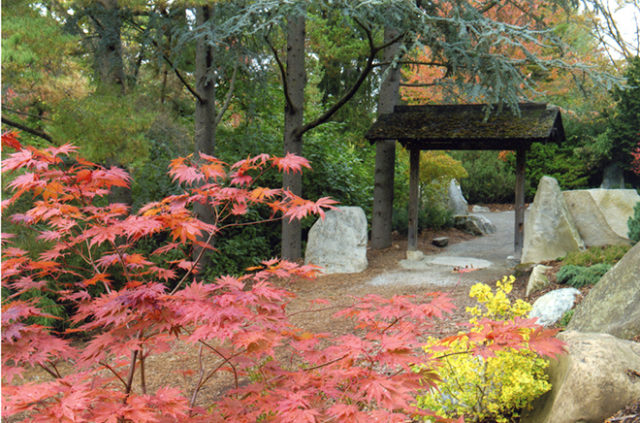By Stephanie Ikeda,
Seattle locals know that Kubota Garden is a public garden tucked away in a quiet part of South Seattle that exhibits both Japanese and Western design influences. With colder weather approaching, the vibrant colors of fall leaves will soon be visiting Kubota Garden, but Kubota Garden Foundation Board President Joy Okazaki wants the community to know that there’s more to the Garden and its history than what’s posted on its website.
Unlike the majority of Japanese gardens in North America, Kubota Garden is the brainchild of artist Fujitaro Kubota, an early Japanese immigrant who was not formally trained in Japanese garden design but ran a successful landscaping business in Seattle for decades. It was Fujitaro’s home as well as his business, and he developed the garden as a community gathering place in addition to a showcase for the business.
During the 1970s, the Kubota family looked to sell the property, but developers were constrained by the designation of the Garden’s core as a City Landmark. The local community eventually convinced the City of Seattle to purchase the property. Kubota Garden is one of the only examples of a garden where a Japanese immigrant lived and worked on the property, designing it himself before it was designated as a public space. Kubota also designed Japanese gardens on the Seattle University campus and the Bloedel Reserve on Bainbridge Island.

Today, the City is responsible for the Garden’s maintenance, but the Foundation is instrumental in garnering financial and volunteer support. The Foundation organizes free tours, events and capital projects such as the recently completed ishigaki “castle” style stone wall at the Terrace Overlook which brought in master masons from Japan. The Foundation also organizes the Spring/Fall Plant Sale fundraisers and annual events. This
year marked the first soapstone carving workshop for youth and a Japanese Iris exhibit. But performances also happen at the garden every summer. Ms. Okazaki says that the Garden is looking to make even more improvements to the garden as well as continue to expand its event offerings over the coming years.
The Foundation also houses a large photo archive, all 2,124 of which are now publicly available on the Densho Digital Repository at Densho.org. The digital archive showcases
photographs from the establishment of the Garden under Fujitaro’s ownership to people enjoying the garden today. The completion of the digitization project was announced at the Foundation’s annual meeting on September 22nd.
Whether enjoying the bright florals of spring or vibrant reds of fall, Kubota Garden is an “urban wilderness” compared to the typical image of a carefully curated Japanese garden. But according to visitors from Japan, the garden still feels very Japanese because it resembles a more deliberate and large scale version of a Japanese household backyard. Fujitaro was famous for his unique fusion style that took advantage of the native
landscape, even creating gardens in the confined desolation of the Minidoka War Relocation Center during World War II. Today, the Japanese American garden is a popular space for people of all cultures and backgrounds. On any given weekend, you might stumble upon a quinceañera, an Indian wedding party, or teenagers doing photo shoots amongst the garden’s natural beauty.
Though Kubota Garden is owned by the City of Seattle as a park space, the partnership with the Kubota Garden Foundation ensures its operations, preservation and growth as a Seattle destination. The Foundation is supported mainly through grants and public donations. Visitors can find out more about this Seattle landmark and how to get involved at kubotagarden.org or on the Kubota Garden Facebook page.









